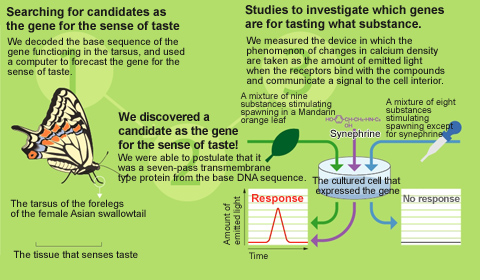|
The adult female butterfly uses its forelegs to taste plant leaves as a clue to identify the plants the larvae eat. The elucidation of this mechanism identified the ties that firmly bind insect and plant, and is the key to understanding the importance of forage conversion in evolution. We decided to search for the gene related to identifying the egg-laying site from the tarsus of the forelegs of the Asian swallowtail, for which we have identified the substance stimulating spawning. We determined the base sequence of more than 10,000 genes functioning on the tarsus, and discovered candidates for the receptor genes for the substance stimulating spawning from among these. We expressed these genes with the cultured cells of the insect, and added the substance known to stimulate spawning for the Asian swallowtail. We were thus able to confirm that their response was to synephrine only.

There is a diversity in the substance stimulating spawning for the Asian swallowtail, the common mormon butterfly, and the spangle, which all feed on leaves of the rutaceae family. Only two chemical substances match, and in fact, one of them is synephrine, which is thought to be important for those who feed on the leaves of the rutaceae family. It might well be the key when considering the speciation of the family papilionidae.
We used the familiar butterfly as a point of entry when we began telling one story in the Biohistory Journal.
|
